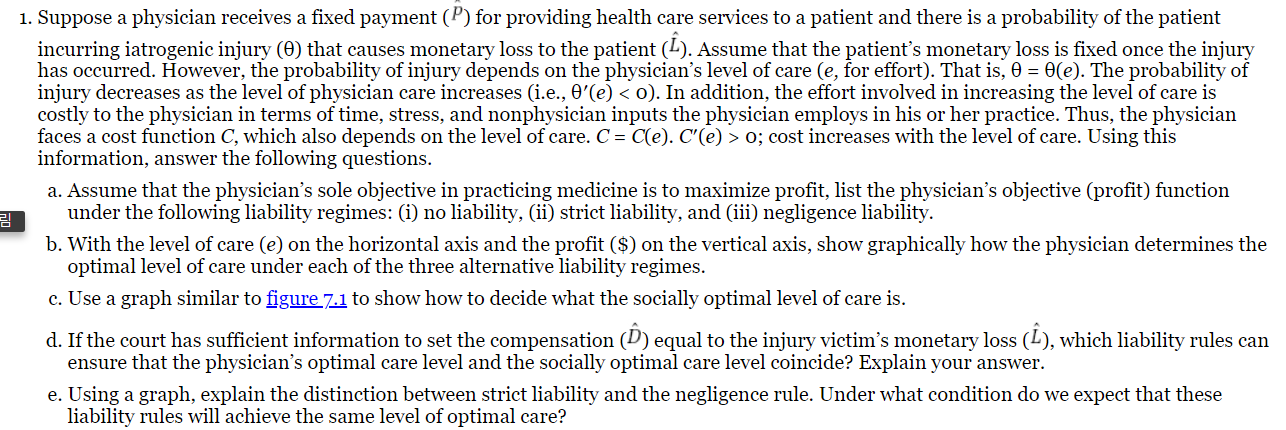
1. Suppose a physician receives a fixed payment (P) for providing health care services to a patient and there is a probability of the patient incurring iatrogenic injury (0) that causes monetary loss to the patient (). Assume that the patient's monetary loss is fixed once the injury has occurred. However, the probability of injury depends on the physician's level of care (e, for effort). That is, 0 = 0(e). The probability of injury decreases as the level of physician care increases (i.e., O'(e) 0; cost increases with the level of care. Using this information, answer the following questions. a. Assume that the physician's sole objective in practicing medicine is to maximize profit, list the physician's objective (profit) function under the following liability regimes: (i) no liability, (ii) strict liability, and (iii) negligence liability. b. With the level of care (e) on the horizontal axis and the profit ($) on the vertical axis, show graphically how the physician determines the optimal level of care under each of the three alternative liability regimes. c. Use a graph similar to figure 7.1 to show how to decide what the socially optimal level of care is. d. If the court has sufficient information to set the compensation () equal to the injury victim's monetary loss (), which liability rules can ensure that the physician's optimal care level and the socially optimal care level coincide? Explain your answer. e. Using a graph, explain the distinction between strict liability and the negligence rule. Under what condition do we expect that these liability rules will achieve the same level of optimal care? 1. Suppose a physician receives a fixed payment (P) for providing health care services to a patient and there is a probability of the patient incurring iatrogenic injury (0) that causes monetary loss to the patient (). Assume that the patient's monetary loss is fixed once the injury has occurred. However, the probability of injury depends on the physician's level of care (e, for effort). That is, 0 = 0(e). The probability of injury decreases as the level of physician care increases (i.e., O'(e) 0; cost increases with the level of care. Using this information, answer the following questions. a. Assume that the physician's sole objective in practicing medicine is to maximize profit, list the physician's objective (profit) function under the following liability regimes: (i) no liability, (ii) strict liability, and (iii) negligence liability. b. With the level of care (e) on the horizontal axis and the profit ($) on the vertical axis, show graphically how the physician determines the optimal level of care under each of the three alternative liability regimes. c. Use a graph similar to figure 7.1 to show how to decide what the socially optimal level of care is. d. If the court has sufficient information to set the compensation () equal to the injury victim's monetary loss (), which liability rules can ensure that the physician's optimal care level and the socially optimal care level coincide? Explain your answer. e. Using a graph, explain the distinction between strict liability and the negligence rule. Under what condition do we expect that these liability rules will achieve the same level of optimal care







